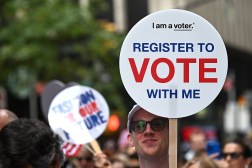Dems introduce bill to halt mass voter roll purges

The Trump administration wants your voter data.
Since President Donald Trump took office in January, the Department of Justice has made an ambitious effort to collect sensitive voter data from all 50 states, including information that one election expert described as “the holy trinity” of identity theft: Social Security numbers, driver’s license numbers and dates of birth.
In states where Trump’s party or allies control the levers of government, this information is handed over willingly. In states where they do not, the DOJ has formally asked, then threatened and then sued states that refuse. The department has also claimed many of these reluctant states are failing to properly maintain their voter registration rolls, and has pushed states to more aggressively remove potentially ineligible voters.
This week, Democrats in the House and Senate introduced new legislation that seeks to defang those efforts by raising the legal bar for states to purge voters based on several factors, such as inactivity or changing residency within the same state.
The Voter Purge Protection Act, introduced by Sen. Alex Padilla, D-Calif., and Rep. Joyce Beatty, D-Ohio, would amend the National Voter Registration Act to make it more difficult for states to kick large numbers of voters off their rolls for actions that Democrats — and many election officials — say are common, overwhelmingly benign and not indicative of voter fraud.
Padilla told reporters that the legislation would help ensure “that Americans cannot be stripped of their right to vote without proof that a voter has either passed away or has permanently moved out of their state.”
Voters targeted for removal must also be notified by election officials “so that there’s no surprise when they show up to vote on election day that their name is not on the list and it’s too late to address whatever the issue may or may not be,” Padilla said.
Beatty pointed to her home state, where Republican Secretary of State Frank LaRose removed more than 155,000 voters from active voter rolls in 2024, as an example where federal protections are needed. The primary factor for purging those voters were records showing they had not cast a ballot in an election for the past four years.
She claimed more than half of the voters who stand to be affected by similar purges in 2025 and 2026 are registered in counties where demographic minorities make up a majority of voters.
“Let me be clear: voting is not use-it-or-lose the right, because too often these so-called voter purges have silenced voices, people of color, people of low income communities, and even our seniors who have waited and fought for the right to vote,” Beatty said.
Meanwhile, a comprehensive post-election audit conducted by LaRose’s office in 2024 identified and referred 597 “apparent noncitizens” on state voter rolls to the state Attorney General for further review, out of 8 million state voters. Critically, 459 of those registered voters never cast an actual ballot, and similar audits performed by LaRose in 2019, 2021 and 2022 found that such people made up similarly miniscule percentages of all active registered voters in the state. Last month, his office put out a press release touting an additional 78 “apparent noncitizens” registered, 69 of whom had no evidence of voting.
“States have the responsibility to keep accurate voter rolls and ensure election integrity,” LaRose added. “In order to meet that responsibility, we need more access to data from the federal government. I will continue to push until we have the resources we need to do our jobs to the standard Ohioans deserve.”
As any state election official will tell you, voter registration lists are never static — every day, people die, get married (or divorced), take on different names, become naturalized citizens or experience a range of other life events that can impact their registration status or result in outdated information. Further, it’s not typically viewed as unusual or a sign of fraud when voters sparingly make use of their registration to vote, though most election experts endorse some level of database maintenance to remove inactive voters.
But it is often these discrepancies that get highlighted by Trump and state allies as evidence of unacceptably messy voter rolls that justify stricter removal policies.
And there are election officials — mostly in Republican-controlled states — who have embraced the philosophy that even small numbers of questionable registrations or voter fraud must be aggressively stamped out or it will lead to American voters losing faith in their democracy. LaRose and Georgia Republican Secretary of State Brad Raffensperger have long championed a similar approach to voter maintenance, and have called for Congress to pass laws making it easier for states to remove voters during election years.
“List maintenance is about election security and voter confidence,” Raffensperger said last month while announcing that approximately 146,000 Georgia voters would be moved to inactive voter rolls, including 80,754 voters who had moved to another county within the state. “We want every Georgian to have full faith in the system, knowing that our elections are free, fair — and fast.”
Critics have pointed out that states already have numerous, effective means for preventing mass voter registration or fraud that have been borne out by post-election audits finding very low instances of fraud, and that overly harsh policies around list maintenance can and do end up disenfranchising far more eligible voters than bad actors. Further, they argue against removing large numbers of voters without a robust follow-up process from states to give affected voters an opportunity to appeal or address any discrepancies that may affect their registration.
The bill has 22 Democratic co-sponsors in the Senate and 24 in the House but is unlikely to gain serious consideration under a Republican-controlled Congress, where most GOP members have long believed voter fraud is rampant and are broadly supportive of state and federal efforts to remove voters based on those same factors.
Asked by CyberScoop how Democrats would navigate that reality, Padilla said the legislation was part of a broader overall effort to push back on these efforts at all levels of constitutional governance. That includes states fighting to protect their constitutional role as administrators of elections when denying data requests from the federal government, within the court system as states and voting rights groups fight in court to block the administration’s use of the SAVE database as a pretext for voter removal, and through public awareness and politics.
Teeing up legislation to prevent states from potentially disenfranchising voters from spurious purges, he said, is part of asserting Congress’ constitutional role in a much broader fight about the way elections are run.
“We’re pushing back on it at every turn and calling attention to it, so that voters understand what they may be facing and make all the necessary preparations so that their right to vote is not denied, whether it’s in next year’s midterm elections or even other regular or special elections before then,” Padilla said.






